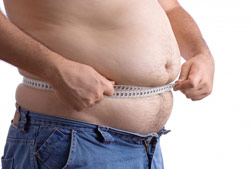3 Lifestyle Changes May Turn Bad Fat to Good Fat

Researchers may have found a new way to put ordinary fat cells to work, changing them from lazy blobs that store our extra calories into energy-burners.
The method is surprisingly simple: keep the mice busy, and give them lots of friends and plenty of room to run around.
After one month in such an "enriched" environment, mice saw some of their white fat cells, which store energy, take on characteristics of brown fat, which burns calories. After three months, the researchers could visually see the white fat turning brown. The new brown fat cells may explain why these mice stayed lean despite being fed a high-fat diet, the researchers said.
Mice not placed in an enriched environment (control mice) did not have changes in their white fat cells, the researchers said.
The same type of transformation from white fat to brown fat might be possible in people, said study researcher Matthew During, a professor of neuroscience at Ohio State University Medical Center. Three lifestyle modifications may be key to triggering this transformation: becoming more socially engaged, presenting yourself with new challenges and staying physically active, During said.
Such advice differs from the tradition mantra of "eat less and exercise more" that people who want to lose weight usually hear, he said.
"This gives a whole new degree of complexity to the approach of treating obesity," During said.
Sign up for the Live Science daily newsletter now
Get the world’s most fascinating discoveries delivered straight to your inbox.
Enriched environment
Mice in the enriched environment were given cages with running wheels, mazes, toys and unlimited food and water. They were also given 15 to 20 housemates. Control mice were housed in groups of five and given standard rodent cages with unlimited food and water, but no toys.
In addition to changes in white fat, after one month, the mice in the enriched environment lost 50 percent more of their abdominal fat than control mice. They also gained 29 percent less weight than control mice, and saw increases in their body temperature.
Exercise alone did not account for these changes. When mice were given just running wheels, but not the other components of the enriched environment, they didn't lose as much weight as the control mice.
New obesity treatment
"This could be a new avenue to counteract obesity," said Yu-Hua Tseng, an assistant professor of medicine at Harvard Medical School, who was not involved in the new study, but has researched ways to change white fat to brown fat. Tseng agreed this transformation, induced by an enriched environment, may be possible in people, though studies on humans need to be conducted before we know.
The researchers said the enriched environment might have stimulated the production of a protein in brain called BDNF. This protein drives changes in the part of your nervous system responsible for the "fight or flight" response, and these changes could be turning on genes in the white fat cells that give them properties of brown fat cells, including the ability to burn calories to generate heat.
It may be possible to activate this pathway with medication, the researchers say.
The researchers want to figure out which components of the enriched environment are crucial to the activation of this pathway, During said. Pass it on: An enriched environment may transform white fat cells to brown fat.
This story was provided by MyHealthNewsDaily, a sister site to LiveScience. Follow MyHealthNewsDaily staff writer Rachael Rettner on Twitter @RachaelRettner. Find us on Facebook.

Rachael is a Live Science contributor, and was a former channel editor and senior writer for Live Science between 2010 and 2022. She has a master's degree in journalism from New York University's Science, Health and Environmental Reporting Program. She also holds a B.S. in molecular biology and an M.S. in biology from the University of California, San Diego. Her work has appeared in Scienceline, The Washington Post and Scientific American.









